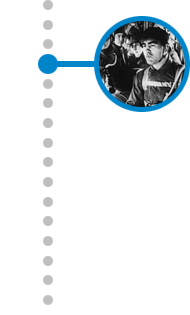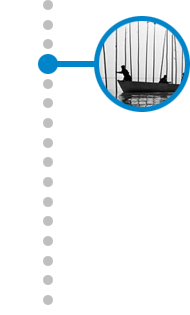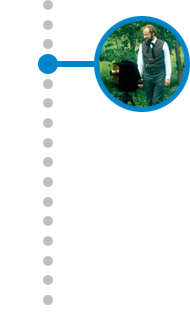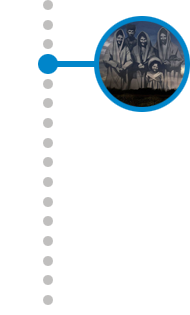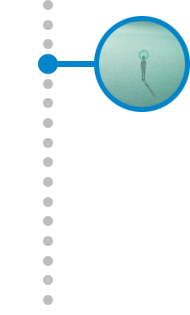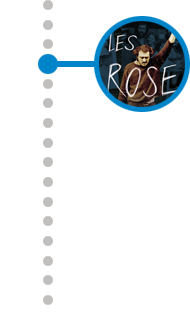Key Moments in NFB History
NFB works have won more than 7,000 awards, including 4 Palmes d’or, 12 Oscars, 21 Webby Awards, 26 Gala Québec Cinéma awards, and over 525 Academy of Canadian Cinema & Television Awards, including 27 Canadian Screen Awards.
1941

Churchill’s Island by Stuart Legg wins an Oscar®, the first to be awarded to a Canadian film.
1952

Neighbours, Norman McLaren’s pixillation masterpiece, earns the NFB its second Oscar® in the Best Documentary (Short Subject) category.
1955

NFB wins its first Palme d’Or (Short Film) at the Cannes Film Festival. Norman McLaren’s Blinkity Blank, an animated work engraved on film and accompanied by a jazz score, claims the honour.
1950s and 1960s

NFB is at the leading edge of developments in documentary cinema. Quebec filmmakers Michel Brault, Marcel Carrière, Gilles Groulx and Pierre Perrault make important contributions to the Direct Cinema movement with such iconic films as Les raquetteurs (Gilles Groulx and Michel Brault, 1958), whose aesthetic is considered a precursor to the Direct Cinema style. The film establishes a new way of representing reality and foreshadows the approach taken by the NFB’s French filmmaking team, which will be deployed in the 1960s, in the heat of an emerging Quebec cinema and assertion of identity. Iconic films are made during this period, including Pour la suite du monde (Of Whales, the Moon and Men) by Pierre Perrault and Michel Brault, La Lutte (Wrestling) by Michel Brault, Marcel Carrière, Claude Fournier and Claude Jutra, Golden Gloves by Gilles Groulx, Bûcherons de la Manouane by Arthur Lamothe and À Saint-Henri le cinq septembre (September Five at Saint-Henri), a group project by the NFB’s French team led by Hubert Aquin, as well as the fiction film Le chat dans le sac (The Cat in the Bag) by Gilles Groulx, which uses Direct Cinema techniques.
1960

NFB produces Universe, a short documentary by Roman Kroitor and Colin Low, which explains the workings of the universe and, a few years later, is included in the American astronaut training program.
The film was also a key source for Kubrick’s vision of space in 2001: A Space Odyssey.
1962

Pour la suite du monde (Of Whales, the Moon and Men) by Pierre Perrault and Michel Brault (produced by Fernand Dansereau; with sound by Marcel Carrière) is the first Canadian feature film to be screened in competition at the Cannes Film Festival.
1963

NFB releases its first English fiction feature: Drylanders by Don Haldane.
1964

NFB’s French Program is created. Up until then, French productions had been developed and managed within the English production unit. This confirms the institution’s commitment to establishing a distinct identity for francophone cinema at the NFB. The same year, the NFB releases its first French-language fiction feature, Le chat dans le sac (The Cat in the Bag) by Gilles Groulx.
1967

NFB’s Challenge for Change program—whose French-language counterpart Société nouvelle would be launched in 1969—sparks a whole new kind of participatory cinema experience, aimed at entire communities.
1967

NFB takes immersive storytelling to a new level with its landmark multi-screen experience In the Labyrinth, shown at Montreal’s Expo 67, which in turn leads to the birth of the IMAX® format and a string of giant-screen firsts. The experimental film by Roman Kroitor, Colin Low and Hugh O’Connor draws more than 1.3 million people.
1968

NFB launches a training program for Indigenous filmmakers, in collaboration with the Department of Indian and Northern Affairs Canada.
1970

The NFB presents two works created for the Canada Pavilion at the Osaka World’s Fair: the spectacular short documentary Canada the Land, by Rex Tasker and Jean-Claude Labrecque, on Canada’s geographic wealth; and The City, by Kaj Pindal, an animated fantasy about the country’s urbanization.
1971

Claude Jutra creates his masterpiece Mon oncle Antoine for the NFB, which garners a Gold Hugo at the Chicago International Film Festival and First Prize for Feature Films at the Canadian Film Awards.
1974

Studio D is created within the English Program. It’s the first studio dedicated to films made by and about women, from which would emerge such landmark works as Not a Love Story: A Film About Pornography by Bonnie Sherr Klein (1981) and If You Love This Planet by Terre Nash (1982). The studio would earn a total of three Oscars®, for I’ll Find a Way (1977), If You Love This Planet and Flamenco at 5:15 (1983).
1974

NFB blazes a trail in computer animation when René Jodoin produces one of the first short films made solely using computer animation, Peter Foldès’s La faim (Hunger), which wins a Jury Prize, short film category, at Cannes and receives an Oscar® nomination.
1976

NFB produces the official film of the XXI Olympiad, under the supervision of Jean-Claude Labrecque (32 teams, 168 people, 100,000 metres of film).
1977

J.A. Martin photographe (J.A. Martin Photographer) triumphs at Cannes. Monique Mercure receives the Palme d’Or for Best Actress, and the film wins the Prix du jury œcuménique. The same year, the film wins the award for Best Feature Film at the Canadian Film Awards.
1978

The Sand Castle, by Co Hoedeman, wins the Oscar® for best animated short film, one of nearly two dozen awards it earned.
1979

The animated short Special Delivery, by Eunice Macaulay and John Weldon, wins an Oscar®.
1980

For the third consecutive year, the NFB wins the Oscar® for best animated short film, this time for Every Child, by Eugene Fedorenko.
1984

Premiere of River Journey, by John N. Smith, the first IMAX® film produced by the NFB for a world’s fair (Louisiana, New Orleans); the film is a striking journey down Canada’s rivers.
1986

Produced by the NFB for the Canada Pavilion at Expo ’86 in Vancouver and made using the IMAX® process, Colin Low and Tony Ianzelo’s Transitions, the first full-colour IMAX® film created entirely using stereoscopic computer animation, draws 1.7 million viewers at Vancouver’s world exposition.
1986

The French Program animation studio opens the Centre d’animatique to continue to push boundaries in the emerging field of computer animation. The team includes Daniel Langlois, founder of Softimage.
1989

The NFB wins an Honorary Oscar® for overall excellence in cinema.
1992

October: NFB launches its CineRobotheque, a centre for cutting-edge media technology, comprising a videotheque and a movie theatre. It contains the first large audiovisual server in Canada, capable of responding to some 50 requests simultaneously from both inside and outside the centre. Kodak Canada awards it the Prix Livernois, underscoring the NFB’s innovative leadership in the field of imaging. The CineRobotheque serves as the model for the creation of the NFB Mediatheque in Toronto in 2002, establishing the NFB’s position very early in the dawning era of digital film distribution.
1992

The first film in IMAX® HD (48 frames per second), Colin Low and Tony Ianzelo’s Momentum is the centrepiece of the Canada Pavilion at the world’s fair in Seville, Spain. The film reveals Canada’s immensity and diversity in a completely immersive and captivating fashion.
1995

Bob’s Birthday, by Alison Snowden and David Fine, wins the Oscar® for best animated short.
2005

Ryan, by Chris Landreth, wins the Oscar® for best animated short, along with some 60 other awards.
2007

The animated short The Danish Poet, by Torill Kove, wins an Oscar®.
2008

Filmmaker-in-Residence, a long-term collaboration with multimedia documentary maker Katerina Cizek, earns the NFB the very first of its Webby Awards, along with many other prizes.
2009

NFB launches NFB.ca | ONF.ca, its acclaimed online screening room, the first fully bilingual and bicultural audiovisual site, in January. Later that year, the NFB launches the first in a family of popular mobile apps, the NFB Films app for iPhone, which was named one of the top apps of 2009 by iTunes Canada and hailed by CNET as “ingenious” and “pure iPhone gold.”
2009

NFB creates its two award-winning digital studios, one based in Vancouver, the other in Montreal.
2010

Created for the Canada Pavilion at Expo Shanghai, Glimpses, by Jean-François Pouliot, depicts 24 hours in the life of an imagined city–a composite that draws on all Canadian cities. This short film is projected onto a semi-circular screen 21 metres wide and 5 metres high, with a curvature of about 150 degrees.
2011

Home of the largest collection of Inuit films in the world, the NFB releases the landmark compilation Unikkausivut: Sharing Our Stories.
2012

Sarah Polley directs Stories We Tell at the NFB. The film breathes new life into the doc genre and becomes one of the biggest critical and commercial successes of all time in Canadian documentary, earning 11 awards and honours (as of October 2020).
2012

NFB earns a double Oscar® nomination with Patrick Doyon’s Sunday and Wendy Tilby and Amanda Forbis’s Wild Life.
2014

During the NFB’s 75th-anniversary celebrations, NFB.ca | ONF.ca and its partner platforms topped 50 million views, and NFB interactive productions and digital platforms were showered with more than 100 awards, including 10 Webby Awards.
2016

On March 8, NFB announces its firm commitment to achieving gender parity. Its goals are to have 50% of its productions made by women and 50% of its production budget devoted to films made by women, by 2019.
2017

Theodore Ushev’s Blind Vaysha is a hit, receiving 28 awards and honours, in addition to an Oscar® nomination.
2017

On March 7, the NFB takes another step forward in its commitment to gender parity, aiming for parity by 2020 in key creative positions for animated, documentary and interactive works in production.
2017

On June 20, the NFB announces the implementation of its Indigenous Action Plan, which includes a series of commitments to support more productions directed by Indigenous artists, while creating protocols and guidelines for the production, distribution and use of archives.
2017

Expo 67 Live, by Karine Lanoie-Brien, is an innovative experience on giant screens, consisting entirely of archival treasures, made to mark the 375th anniversary of Montreal and the 50th anniversary of Expo 67. More than 18,000 people attend presentations of this work at the Place des Arts Esplanade in Montreal in September.
2018

Eva Cvijanović’s Hedgehog’s Home (2017) wins 32 awards and honours, including the Telefilm Canada Prize for the most internationally awarded film at the Rendez-vous Québec Cinéma’s Prends ça court Gala.
2018

Launch of the Indigenous Cinema web page on NFB.ca, which features films by and about Indigenous creators. The NFB has also adopted the Indigenous Materials Classification Schema to catalogue these works, the largest online collection of Indigenous-directed films in the world.
2019

Alison Snowden and David Fine’s animated short Animal Behaviour receives the NFB’s 75th Oscar® nod.
2019

After more than 60 years on Côte-de-Liesse Road, the NFB moves into its new headquarters in Îlot Balmoral, in the heart of Montreal’s Quartier des Spectacles.
2020

Women in Governance awards the NFB Platinum Parity Certification, the organization’s highest gender-parity certification level. The NFB was awarded this prestigious certification again in 2021.
2020

Between April and July, during the COVID-19 pandemic, the number of views on NFB.ca | ONF.ca reached a record high of nearly 1.5 million, an increase of more than 95% compared to the same period the previous year. In August, the NFB launches The Curve, a collection of projects by over 40 creators and filmmakers exploring the pandemic, accessible online and produced by all of its studios across Canada.
2020

Distinguished documentarian Alanis Obomsawin is awarded the Glenn Gould Prize, presented once every two years to recognize a unique lifetime contribution that has enriched the human condition through the arts.
2020

In December, the NFB presents its 2020–2023 Strategic Plan—a catalyst for the future of the NFB, which places creation and audience engagement at the heart of the organization’s objectives.
2021

In February, the NFB announces its diversity, equity and inclusion commitments, laid out in a plan that contains concrete goals and measures aimed at making significant and lasting changes in the organization.
2021

In June, the feature film Les Rose (The Rose Family), by Félix Rose, becomes the first documentary to win the Audience Choice award at the Gala Québec Cinéma, following a very successful theatrical and online release.
2021

In September, the interactive installation TRACES is unveiled at Expo 2020 in Dubai. Created by the architectural collective KANVA, with art director and multimedia designer Étienne Paquette, it offers a poetic vision of an uncertain future, and a reflection on our present. The work also can be found in an experiential web version created by Akufen, The Future in Mind.
2022

The NFB earns its 76th Oscar® nomination—more than any other film organization based outside of Hollywood—for the animated short film Affairs of the Art, by Joanna Quinn and Les Mills.
2022

In 2022, six years after making its initial commitment, the NFB continues to meet its gender-parity goals, both for the number of productions directed by women and for production budgets allocated to women. It has also met or exceeded its goals in most creative positions (screenwriting, editing and music composition), with a significant improvement in cinematography.
2022

Five years after the launch of its Indigenous Action Plan, the NFB continues to set priorities and maintain its goals and commitments to support First Nations, Inuit and Métis perspectives.
2022

From February to April, the Haus der Kulturen der Welt in Berlin is presenting “The Children Have to Hear Another Story – Alanis Obomsawin,” an exhibition tracing Obomsawin’s artistic activism over the last five decades. In the spring, the Hot Docs festival is presenting the world premiere of Ms. Obomsawin’s new film, Bill Reid Remembers, her 54th film in a legendary career spanning 55 years.

